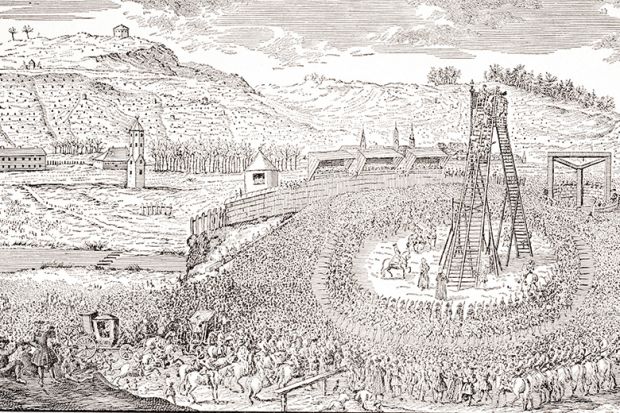Some trials define an epoch. The decade-long “affair” generated by the trial of Alfred Dreyfus (1894-1906) exposed the deep fissures in post-revolutionary France; the 1953 trial of a prominent group of Jewish doctors in Moscow (accused of conspiring to assassinate the Soviet leadership) highlighted the excesses of Stalinism; and the imprisonment of Nelson Mandela in 1964, after the Rivonia Trial, came to characterise the inequities of apartheid South Africa – which ended when Mandela was released in 1990. Each of these trials exposed the limits of law when racism and anti-Semitism shaped the political sphere.
The deformation of law by prejudice has a particularly long history. In Germany, the trial and execution of Joseph Süss Oppenheimer in 1737 has the same symbolic resonance as Dreyfus, Rivonia and the “doctors’ plot” has in France, South Africa and Russia. For Yair Mintzker, the trial of “Jew Süss” is “to the German collective imagination what Shakespeare’s Shylock is to the English-speaking world”. The trial of Shylock in The Merchant of Venice (1597) was inspired by the 1594 trial and execution of the Portuguese-Jewish physician to Queen Elizabeth, Rodrigo Lopez, who was accused of poisoning her. But it is Shylock and not Lopez who has entered English culture, just as it is “Jew Süss” and not Oppenheimer (fabrication and not reality) who is part of German culture.
Oppenheimer was the principal financial adviser to Duke Carl Alexander of the small German state of Württemberg. He was the master of the mint and was given extensive trading privileges as a result of this elevated position. Although he was one of hundreds of “court Jews” dotted throughout the Holy Roman Empire, whose cosmopolitan trading networks and upward mobility were valued and resented in equal measure, Oppenheimer seems to have been particularly wealthy and influential. His supposed power, however, proved illusory and, when the duke died suddenly in 1737, he was immediately arrested and gradually transformed into the fictive “Jew Süss”. He was accused of “damnable maltreatments of prince and country”, vague charges that were later specified to include treason, embezzlement, adultery and debasement of the coinage. He was tortured for information to reinforce the indictment, his many properties were confiscated to pay for the inquisition, and he was executed 11 months later. This treatment was rightly described as “judicial murder” by Carl Alexander’s son, Duke Carl Eugen, a few years later. As many as 20,000 people, from far and wide, witnessed Oppenheimer’s execution on a bright red gallows. After the hanging, his deformed body was placed on permanent display in a bespoke iron gibbet.
“Jew Süss” is remembered today mainly because of the repugnant 1940 Nazi propaganda film, commissioned by Joseph Goebbels, purportedly about Oppenheimer’s life but in reality about the financial and sexual rapacity of German Jewry. The film, directed by Veit Harlan, was a response to a 1934 British film that highlighted the persecution of German Jewry as Hitler came to power. The British film, directed by Lothar Mendes, was in turn based on a 1925 best-selling novel by Lion Feuchtwanger, translated into English in 1926. All of the films and novels were called Jew Süss. Oppenheimer’s meteoric rise and stupendous fall, in other words, has become an abiding allegory for the fate of German Jewry.
Rather than the post-history of Oppenheimer, Mintzker shows that his “many deaths” cannot be separated from the diverse ways in which he was imagined by his contemporaries. To this end, he focuses on four figures: Philipp Friedrich Jäger, the judge-inquisitor; Christoph David Bernard, a converted Jew who saw Oppenheimer on the eve of his execution; Mordecai Schloss, a fellow “court Jew” in Württemberg; and David Fassmann, a popular writer of courtly intrigues. All of these figures wrote first-hand accounts of Oppenheimer or produced court documents (interviews, translations, contributions to the inquisitorial process). These documents are interpreted with consummate skill and weighed for their veracity, since “not all historical sources are created equal”. Despite an archive made up of thousands of documents (along with dozens of memoirs and interpretive accounts), there is no “actual” person whom the historian can retrieve. Oppenheimer, in Mintzker’s words, was “twice removed from the truth”; he could not speak for himself during his trial, and was relatively anonymous before his arrest. Instead, the documents produced by “the judge”, “the convert”, “the Jew” and “the writer” are contextualised and humanised to show the complex ways in which Oppenheimer was represented according to widely differing social, religious and political ends.
Jäger wrote the narrative of Oppenheimer’s alleged crimes that led to the death sentence, and he undoubtedly drew his “facts” from “a predetermined conclusion” (not least his prurient interest in Oppenheimer’s alleged sexual conquests). But the competing social and political spheres in which Jäger and Oppenheimer operated, rather than any innate prejudice, determined why Jäger pursued his quarry with such fanatical energy. Jäger was a prominent member of the mainly Lutheran Ehrbarkeit (“the honourables”), a large network of the haute bourgeoisie who populated Württemberg with bureaucrats and professionals and were independent of the duke’s authority. It was in this context that Oppenheimer became the antithesis of the Ehrbarkeit, a “shadowy agent, the real cause of Jäger’s own stalling career”. Württemberg was fragmented, a Lutheran duchy ruled by a Catholic duke. This explains why Oppenheimer, in one incarnation, was deemed to be “a creature of the unholy matrimony between Jews and papish princes”. Such is the anti-Catholic dimension to Oppenheimer’s persecution.
Jäger’s legal testimony is fittingly described as a mixture of “rumours, gossip, outright lies and (at best) half-truths”. Bernard and Schloss, on the other hand, viewed Oppenheimer through the prism of the biblical stories of, respectively, King David and Joseph. They were in competition with Oppenheimer, Bernard as a relatively impoverished Jewish convert, and Schloss as a fellow “court Jew”, which meant that both had particular axes to grind in their desire to harm Oppenheimer. Only Fassmann, who imagined a dead Oppenheimer in the underworld, wrote a series of three unalloyed fictions, which changed according to the mood of the times. What is clear from Mintzker’s inspired readings is that Oppenheimer became a cipher for much larger issues that had little to do with his actions. But it remains a mystery why “Jew Süss”, and no other “court Jew” in the Holy Roman Empire, was singled out for persecution.
The gulf between the actual Oppenheimer and the fictive “Jew Süss” is unbridgeable, which turns the subject of the book into a “structuring absence” or Jewish “Godot”. Mintzker’s response to this impasse is to write a “polyphonic history” that places four radically varied narratives in a fruitful dialogue. The main fault of this brilliant account is that the author is all too aware how clever it is. This is, alas, reinforced at the end of each chapter with “conversations” between “Mintzker” and a critical reader. Is it really necessary to hear how “intriguing” the argument is, that a chapter “worked quite well” or that the book as a whole has a “gospel structure”? Yet it can’t be denied that Mintzker has a great deal to be pleased about and he is right to hope that his “polyphonic” challenge to mainstream historiography will be successful.
Bryan Cheyette is professor of modern literature and culture at the University of Reading. He is currently working on a short book about The Ghetto for Oxford University Press.
The Many Deaths of Jew Süss: The Notorious Trial and Execution of an Eighteenth-Century Court Jew
By Yair Mintzker
Princeton University Press, 344pp, £27.95
ISBN 9780691172323
Published 7 June 2017

The author
Yair Mintzker, associate professor of history at Princeton University, was born in Jerusalem, which he describes as “a tough, complicated and often violent city, which is also fascinating and indeed beautiful and profound. Even now, many years after leaving the city of my birth, my early experiences there continue to shape the way that I think about the world.”
He studied at Tel Aviv University and LMU Munich, although he found the experience “quite chaotic. I took classes in philosophy, literature, sociology, physics and even maths before difficult personal circumstances forced me to interrupt my studies. When I resumed my education, I homed in on history – a discipline that I thought would be flexible enough to satisfy my many conflicting interests. It was a decision that I never regretted.”
Already the author of The Defortification of the German City, 1689-1866 (2012), Mintzker believes that it is “in [his] intellectual DNA to look at cultural phenomena from different angles and to search for more than one answer to the question ‘Why?’ Coming across the case of ‘Jew Süss’ was a godsend in that respect. I was drawn to the many uncertainties and contradictions in the case; that any attempt to reduce it to one plot line was bound to misrepresent it. Inspired among others by Japanese film director Akira Kurosawa’s Rashomon and Orhan Pamuk’s masterful novel My Name is Red, I decided to write four parallel accounts of the trial.”
Yet Mintzker also sees the story as “a powerful parable about the modern world. This is why ‘Jew Süss’ continues to star in so many novels, films and plays, but also history books such as mine. Many contemporary politicians – including US president Donald Trump’s son-in-law Jared Kushner – are often compared with ‘Jew Süss’. This is a sign that the trial, although it was concluded almost three centuries ago, is not quite over yet.”
Matthew Reisz
POSTSCRIPT:
Print headline: When prejudice deforms the law
Register to continue
Why register?
- Registration is free and only takes a moment
- Once registered, you can read 3 articles a month
- Sign up for our newsletter
Subscribe
Or subscribe for unlimited access to:
- Unlimited access to news, views, insights & reviews
- Digital editions
- Digital access to THE’s university and college rankings analysis
Already registered or a current subscriber?




